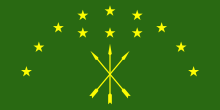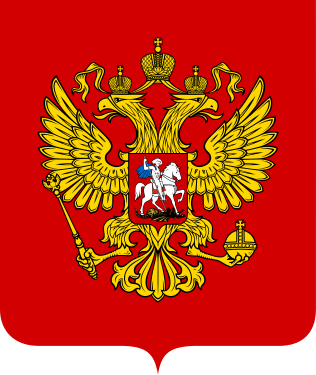Adyghe people
The ethnonym Adyghe (Adyghe: Адыгэ, romanized: Adygè; Russian: Адыги, romanized: Adygi) is used as an endonym by the Caucasian-speaking Circassians of the North Caucasus. The name Adyghe (also transliterated as Adyga, Adyge, Adygei, Adyghe, Attéghéi) is believed to derive from atté "height" to signify a mountaineer or a highlander, and ghéi "sea", signifying "a people dwelling and inhabiting a mountainous country near the sea coast", or "between two seas".[6][7]
| Total population | |
|---|---|
| 250,000 (est) | |
| Regions with significant populations | |
| 124,835 107,048 13,834 584[1] | |
| 600[2] | |
| 4,000[3][4]–5,000[5] | |
| Languages | |
| Adyghe (native), Russian | |
| Religion | |
| Predominantly Sunni Islam with Khabzeist, irreligious and Christian minorities | |
| Related ethnic groups | |
| Other Circassians and Abazgi (Abkhaz, Abazin) | |
Adyghe is also used to describe those who speak the Adyghe language or 'West Circassian'. The Circassian peoples are divided into tribes or clans (tlapq). Of the twelve Circassian tribes, ten are Adyghe tribes (or subgroups),[8][9] out of which four are identified as speaking mutually intelligible Adyghe dialects: Abzakh, Bzhedug, Temirgoy and Shapsug.[8][10]
Most Adygheans in Russia are inhabitants of the Republic of Adygea, a federal subject of Russia located in the southwestern part of European Russia, enclaved within Krasnodar Krai, where it is used to describe them as a demonym. Their name is also rendered as Adygeans (Russian: Адыгейцы, romanized: Adygeytsy).[a] There are also smaller numbers of Adygheans in the regions surrounding Adygea in Krasnodar Krai.
Ethnology
The Adyghe people are one of the Circassian peoples, along with the Cherkess (of Karachay-Cherkessia) and Kabards (of Kabardino-Balkaria), from whom they are geographically separated by the Slav-inhabited Laba region.[11] The Adyghe language is mutually intelligible with that of the Cherkess and Kabards, which is Kabardian or 'East Circassian'. However, there is a consensus that these are typologically distinct languages.[12] The standard (literary) Adyghe language is based on the dialect of the Temirgoy tribe.[10]
The Adygheans, known as "western Circassians" per Soviet terminology from the 1930s, use a written language separated by Soviet policy from those of the Cherkess ("central Circassians") and Kabards ("eastern Circassians"), despite the possibility to have a unified one. The Adyghe-Cherkess Autonomous Oblast was established in July 1922, "Cherkess" being dropped from the name in August 1936.[13]
Population
.png)
According to the 2010 census of Russia, the number of self-declared ethnic "Adyghe" is 124,835 (0.09%). The community included 107,048 in Adygea itself (ca. 25% of the republic's population), 13,834 in Krasnodar Krai, 569 in Moscow.[14] The majority of the population in Adygea declare as Russians (63.6%). In 2002 it was estimated that the community numbered 131,000 in all of Russia.[11] The other closely related groups, Kabards and Cherkess, numbered 516,826 (0.38%) and 73,184 (0.05%), respectively.[14] Those that declared as Shapsug, who speak an Adyghe dialect and are regarded an Adyghe subgroup, were counted as a separate ethnic group in the censuses and numbered 3,882.[14]
There is a significant Adyghe diaspora. It was estimated in 1997 that there were 71,000 Adyghe-speakers in Turkey, 44,000 in Jordan, and 25,000 in Syria.[15]
History
The political history of the Adyghe in Adygea since the Russian Revolution is complex. On 27 July 1922, a Circassian (Adygea) Autonomous Oblast was established in the Kuban-Black Sea Oblast, which would later become Krasnodar Krai. After several name changes, the Adyghe Autonomous Oblast was established on 3 August 1928. On 5 October 1990, the Adygea ASSR was proclaimed and separated from Krasnodar Krai. On 24 March 1992, it became the Republic of Adygea. A significant population of the Adyghe community now lives in the Black Sea region of Northern Turkey where their culture is preserved in villages in the area.[16]
Annotations
- ^ In Russian, Adygea's Circassian residents are called Adygejtsy (Адыгейцы, meaning 'those [of the Republic] of Adygea'), whereas the Circassians in general are called Adygi (Адыги, meaning 'the Adyghe'). In English terminology, on the other hand, many foreigners fail to distinguish between these Russian-specific administrative (former) and ethnolinguistic (latter) terms, and misuse the word Adyghe to refer only to the Adyghe in Republic of Adygea (only a small part of the historical Circassian lands). The majority of the Circassians in Russia today reside in neighbouring regions of Adygea.
References
- Официальный сайт Всероссийской переписи населения 2010 года. Информационные материалы об окончательных итогах Всероссийской переписи населения 2010 года (in Russian)
- "About number and composition population of Ukraine by data All-Ukrainian census of the population 2001". Ukraine Census 2001. State Statistics Committee of Ukraine. Archived from the original on 17 December 2011. Retrieved 17 January 2012.
- Besleney, Zeynel Abidin (2014). The Circassian Diaspora in Turkey: A Political History. Routledge. p. 96. ISBN 978-1317910046.
- Torstrick, Rebecca L. (2004). Culture and Customs of Israel. Greenwood Publishing Group. p. 46. ISBN 978-0313320910.
- Louër, Laurence (2007). To be an Arab in Israel. Columbia University Press. p. 20. ISBN 978-0231140683.
- Spencer, Edmund, Travels in the Western Caucasus, including a Tour through Imeritia, Mingrelia, Turkey, Moldavia, Galicia, Silesia, and Moravia in 1836. London, H. Colburn, 1838. p. 6.
- Loewe, Louis. A Dictionary of the Circassian Language: in Two Parts: English-Circassian-Turkish, and Circassian-English-Turkish. London, Bell, 1854. p. 5.
- Olson, Pappas & Pappas 1994, p. 15.
- Minahan 2002, p. 37.
- Michael Fortescue; Marianne Mithun; Nicholas Evans (29 July 2017). The Oxford Handbook of Polysynthesis. Oxford University Press. pp. 949–. ISBN 978-0-19-968320-8.
- Minahan 2002, p. 36.
- Hewitt, George (2005). "North West Caucasian" (PDF). Lingua. 115 (1–2): 17. doi:10.1016/j.lingua.2003.06.003.
- Olson, Pappas & Pappas 1994, p. 152.
- 2010 census of Russia
- Anatole Lyovin (1997). An Introduction to the Languages of the World. Oxford University Press. pp. 57–. ISBN 978-0-19-508116-9.
- "Adyghe in Turkey". Archived from the original on 2011-08-21. Retrieved 2014-09-16.
Sources
- James Minahan (2002). "Adyge". Encyclopedia of the Stateless Nations: A-C. Greenwood Publishing Group. ISBN 978-0-313-32109-2.
- Alexandre Bennigsen; S. Enders Wimbush (1986). Muslims of the Soviet empire: a guide. Indiana University Press. ISBN 978-0-253-33958-4.
- James Stuart Olson; Lee Brigance Pappas; Nicholas Charles Pappas (1994). An Ethnohistorical Dictionary of the Russian and Soviet Empires. Greenwood Publishing Group. pp. 152–. ISBN 978-0-313-27497-8.

